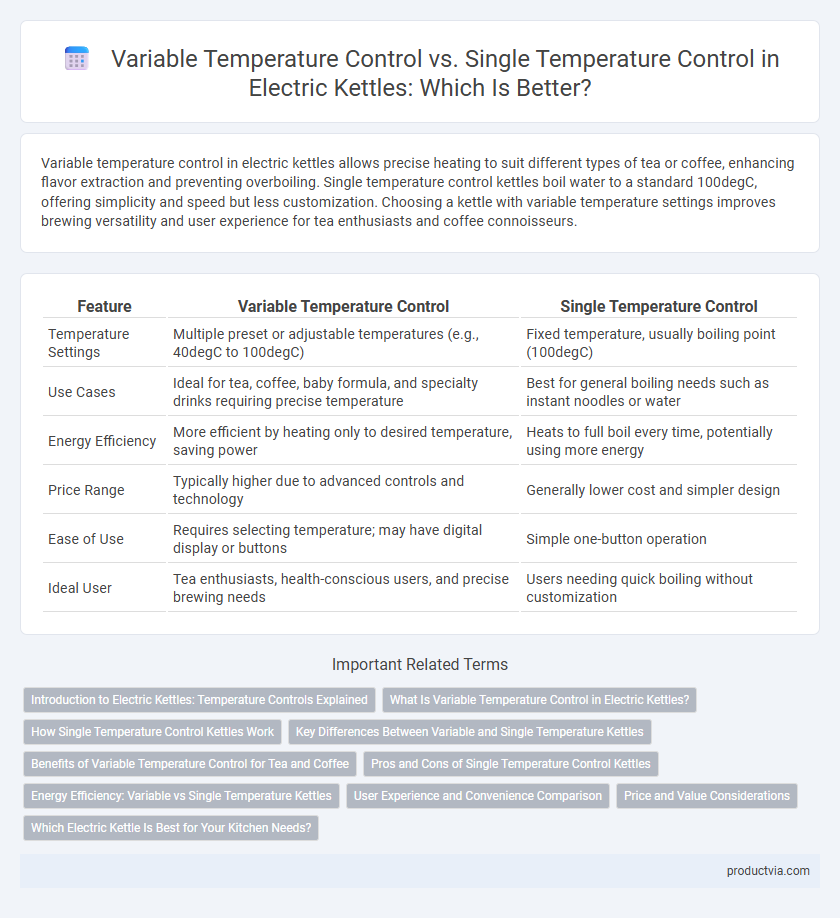Variable temperature control in electric kettles allows precise heating to suit different types of tea or coffee, enhancing flavor extraction and preventing overboiling. Single temperature control kettles boil water to a standard 100degC, offering simplicity and speed but less customization. Choosing a kettle with variable temperature settings improves brewing versatility and user experience for tea enthusiasts and coffee connoisseurs.
Table of Comparison
| Feature | Variable Temperature Control | Single Temperature Control |
|---|---|---|
| Temperature Settings | Multiple preset or adjustable temperatures (e.g., 40degC to 100degC) | Fixed temperature, usually boiling point (100degC) |
| Use Cases | Ideal for tea, coffee, baby formula, and specialty drinks requiring precise temperature | Best for general boiling needs such as instant noodles or water |
| Energy Efficiency | More efficient by heating only to desired temperature, saving power | Heats to full boil every time, potentially using more energy |
| Price Range | Typically higher due to advanced controls and technology | Generally lower cost and simpler design |
| Ease of Use | Requires selecting temperature; may have digital display or buttons | Simple one-button operation |
| Ideal User | Tea enthusiasts, health-conscious users, and precise brewing needs | Users needing quick boiling without customization |
Introduction to Electric Kettles: Temperature Controls Explained
Variable temperature control in electric kettles allows precise heating to specific temperatures, enhancing flavor extraction for different beverages like green tea, coffee, and herbal infusions. Single temperature control kettles heat water to a fixed boiling point, offering simplicity and speed ideal for general use such as boiling water for instant noodles or black tea. Choosing between these controls depends on the user's preferences for convenience versus customizable brewing temperature precision.
What Is Variable Temperature Control in Electric Kettles?
Variable temperature control in electric kettles allows users to select and maintain precise water temperatures tailored for different beverages, such as green tea, coffee, or herbal infusions. This feature enhances brewing accuracy by offering multiple preset temperature settings, typically ranging from 140degF to 212degF, unlike single temperature kettles that heat water only to boiling point. Advanced temperature sensors and digital displays in variable control kettles improve convenience and optimize flavor extraction by preventing overheating.
How Single Temperature Control Kettles Work
Single temperature control electric kettles heat water to a preset temperature, usually boiling point, using a simple on-off mechanism controlled by a thermostat. Once the water reaches the set temperature, the kettle automatically shuts off to prevent overheating. These kettles offer reliable and straightforward operation without customizable temperature settings, ideal for users who primarily need boiling water.
Key Differences Between Variable and Single Temperature Kettles
Variable temperature control electric kettles offer precise settings, allowing users to choose specific temperatures ideal for different beverages like green tea, coffee, or baby formula. Single temperature kettles heat water to a fixed boiling point, typically 100degC, providing simplicity but less versatility for specialized brewing needs. The key difference lies in user control and temperature customization, where variable models enhance brewing accuracy and taste, while single temperature kettles prioritize straightforward operation.
Benefits of Variable Temperature Control for Tea and Coffee
Variable temperature control in electric kettles allows precise heating tailored to different types of tea and coffee, preserving delicate flavors and aroma. This feature ensures optimal extraction by maintaining specific temperature ranges, such as 175degF for green tea and 205degF for French press coffee. Compared to single temperature control kettles, it enhances beverage quality, reduces bitterness, and supports diverse brewing preferences.
Pros and Cons of Single Temperature Control Kettles
Single temperature control electric kettles provide simplicity and ease of use, making them ideal for users who primarily boil water for tea, coffee, or instant meals. They typically heat water faster and have a lower price point compared to variable temperature models, offering convenience and cost efficiency. However, the lack of temperature customization limits precision for specialty teas or brewing methods requiring specific water temperatures, reducing versatility for connoisseurs.
Energy Efficiency: Variable vs Single Temperature Kettles
Variable temperature control electric kettles offer enhanced energy efficiency by allowing precise heating to the desired temperature, reducing unnecessary energy consumption commonly seen in single temperature kettles that always boil water to 100degC. By heating only to the required temperature, variable temperature kettles minimize energy waste, especially for tasks like brewing tea or coffee that require lower temperatures. In contrast, single temperature kettles consume more electricity by repeatedly heating water to boiling point, resulting in higher energy usage over time.
User Experience and Convenience Comparison
Variable temperature control electric kettles enhance user experience by allowing precise selection of water temperatures, catering to different beverages such as green tea, coffee, or baby formula. Single temperature control kettles offer simplicity and faster boiling times but lack customization, which may limit convenience for users with diverse brewing needs. Investing in a variable temperature kettle improves overall convenience by combining versatility with ease of use, ideal for households with varied preferences.
Price and Value Considerations
Electric kettles with variable temperature control typically cost more due to advanced features allowing precise water heating for different beverages, offering enhanced value for tea and coffee enthusiasts seeking optimal brewing. Single temperature control kettles are generally more affordable, providing straightforward boiling functionality suitable for users prioritizing budget over customization. Evaluating the price-to-value ratio depends on the user's need for versatility versus simplicity in water temperature settings.
Which Electric Kettle Is Best for Your Kitchen Needs?
Variable temperature control electric kettles offer precise heating options ideal for brewing diverse teas and coffee types, improving flavor extraction and user customization. Single temperature control kettles efficiently boil water quickly, making them suitable for everyday tasks like instant noodles or general hot water needs. Choosing between these models depends on your kitchen habits and whether you value versatility or simplicity in temperature settings.
Variable temperature control vs single temperature control for electric kettle Infographic

 productvia.com
productvia.com